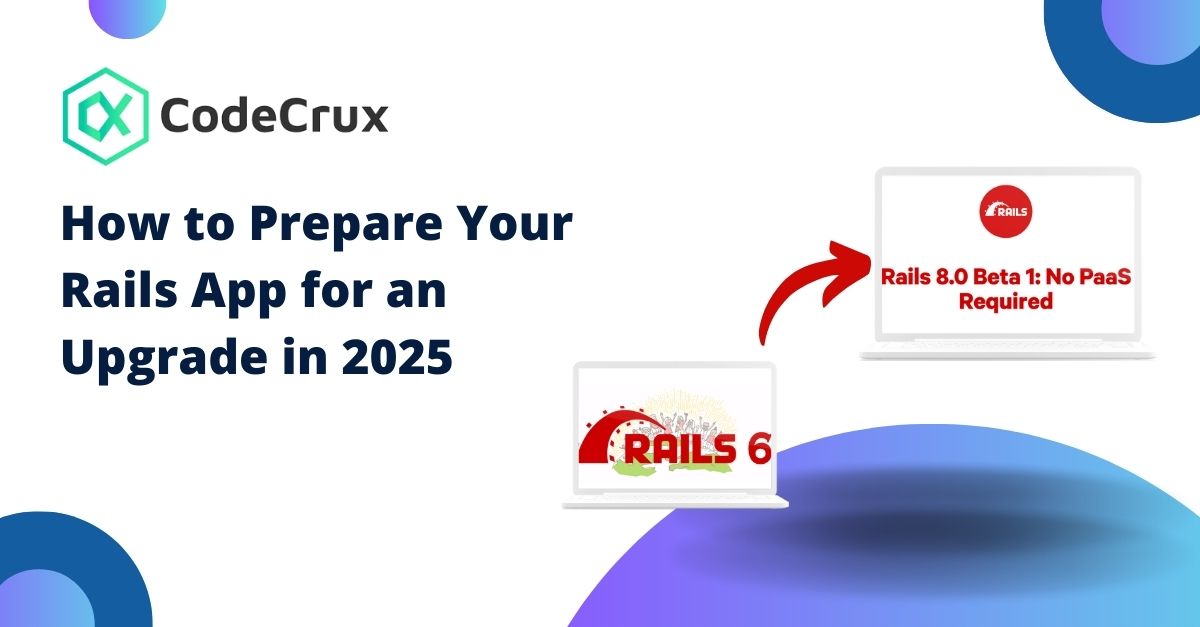How to Prepare Your Rails App for an Upgrade in 2025

How to Prepare Your Rails App for an Upgrade in 2025
Ruby on Rails is a robust framework that evolves rapidly, with each release bringing new features, performance improvements, and security enhancements. However, preparing for an upgrade can be a complex task, especially if your application hasn’t been regularly maintained. In this guide, we’ll outline the steps to prepare your Rails app for an upgrade in 2025, along with pro tips to make the process seamless.
Why Prepare for an Upgrade?
Upgrading a Rails app isn’t as simple as running a single command. Without proper preparation, you risk breaking your application or introducing bugs. A well-planned upgrade ensures:
- Minimal Downtime: Your app continues to serve users without significant interruptions.
- Better Compatibility: Your app remains compatible with modern dependencies.
- Improved Performance: You take advantage of performance optimizations in newer Rails versions.
- Enhanced Security: You stay protected from vulnerabilities addressed in updates.
Step-by-Step Guide to Prepare for a Rails Upgrade
Step 1: Assess Your Current Environment
Understanding your current setup is crucial. Start by answering the following questions:
- What is your current Rails version?
- What Ruby version is your app running?
- Which dependencies and gems are in use?
- What is the state of your test suite?
Run the following commands to gather insights:
1
2
3
rails -v # Check your Rails version
ruby -v # Check your Ruby version
bundle outdated # List outdated gems
Pro Tip: Document your findings in a readiness report to track progress during the upgrade.
Step 2: Read the Release Notes
Each Rails release comes with detailed release notes outlining:
- New features
- Breaking changes
- Deprecations
Visit the Rails Guides or the official GitHub repository for release notes. Focus on versions between your current version and the target version.
Pro Tip: Create a checklist of breaking changes and deprecated features relevant to your app.
Step 3: Update Your Dependencies
Outdated gems are one of the biggest hurdles during a Rails upgrade. To address this:
- Run
bundle outdatedto identify outdated dependencies. - Update gems incrementally using:
1
bundle update gem_name
- Replace unmaintained gems with alternatives.
- Review compatibility of your gems with the target Rails version.
Pro Tip: Prioritize updating gems with known compatibility issues or those integral to your app, such as devise, pundit, or activeadmin.
Step 4: Strengthen Your Test Suite
A robust test suite is your safety net during an upgrade. Ensure you have:
- High test coverage for models, controllers, and views.
- Integration tests for critical workflows.
- End-to-end tests for user-facing features.
Run your tests frequently as you prepare for the upgrade:
1
2
bundle exec rspec # For RSpec
test/test_helper.rb # For Minitest
Pro Tip: Use code coverage tools like SimpleCov to identify untested areas of your application.
Step 5: Remove Deprecated Features
Rails often deprecates older methods and features. Use the following commands to identify deprecations:
- Run your app in development mode to check for warnings.
- Use the
rails upgradegem:1
gem install rails-upgrade
Address all deprecations before proceeding.
Pro Tip: Refactor code incrementally and commit changes frequently to isolate issues.
Step 6: Upgrade Ruby First
Rails upgrades often require a specific Ruby version. Upgrade Ruby before tackling Rails:
- Install the required Ruby version:
1
rbenv install 3.2.0 - Update
.ruby-versionin your project. - Run tests to ensure compatibility.
Pro Tip: Use gem install bundler to ensure your Bundler version is compatible with the new Ruby version.
Step 7: Clean Your Application
A clean codebase reduces friction during upgrades. Consider:
- Removing Unused Code: Delete unused classes, methods, and views.
- Optimizing Your Schema: Remove unused database columns and indexes.
- Simplifying Configurations: Standardize environment configurations.
Pro Tip: Use tools like rails_best_practices to identify code smells and unused methods.
Step 8: Plan Incremental Upgrades
Avoid upgrading multiple Rails versions at once. Instead:
- Upgrade one major version at a time (e.g., from Rails 6.0 to 6.1).
- Test your app after each version upgrade.
- Deploy to a staging environment for additional testing.
Pro Tip: Use feature flags to toggle new features incrementally during the upgrade process.
Step 9: Use a Staging Environment
Before deploying to production, test the upgraded app in a staging environment:
- Deploy the upgraded app to a staging server.
- Run tests and simulate real-world usage.
- Fix any remaining issues before production deployment.
Pro Tip: Use tools like Honeybadger or Sentry to catch errors during staging tests.
Post-Upgrade Best Practices
1. Monitor Production Logs
Keep an eye on logs for unexpected errors after deploying the upgraded app:
1
tail -f log/production.log
2. Optimize Performance
After the upgrade, profile your app using tools like rack-mini-profiler to identify and fix bottlenecks.
3. Document the Upgrade Process
Maintain detailed documentation of your upgrade process, including steps, issues encountered, and their solutions. This will save time during future upgrades.
Pro Tip: Share your findings with the Rails community to help others.
Conclusion
Preparing your Rails app for an upgrade in 2025 is a systematic process that involves assessment, planning, and execution. By following this guide and adopting the pro tips shared, you can minimize risks and ensure a smooth transition to the latest Rails version. Regular maintenance, such as updating dependencies and cleaning up code, will make future upgrades even easier.
Happy upgrading!